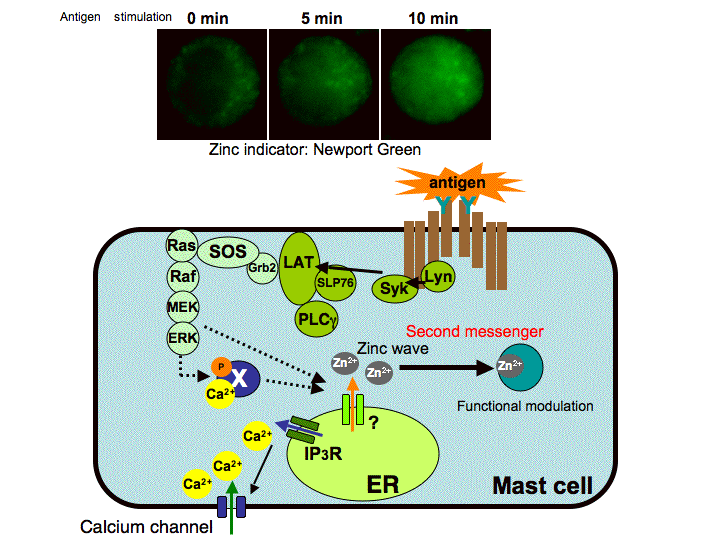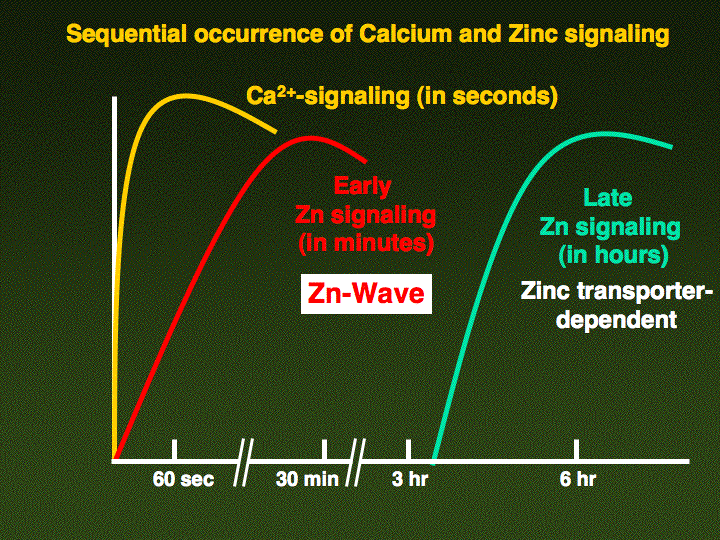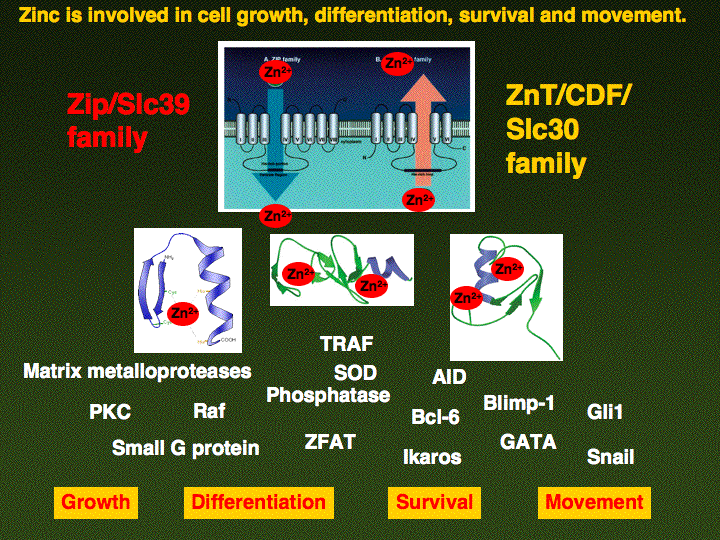ADDRESSLaboratory of Developmental Immunology(C7) 2-2, Yamada-oka Suita, Osaka 565-0871, Japan TEL:81-6-6879-3880 |
AchievementsZinc is a novel intracellular second messengerZinc Wave !!In 1957 Earl W. Sutherland and his colleagues found that cAMP functions as a second messenger. Then calcium was second. There is a limited number and modes of signal transduction mechanisms known, including cAMP, calcium, NO lipid mediators, protein phosphorylation, nuclear receptor so on. Here we found that zinc is a novel second messenger. Zinc is an essential trace element required for enzymatic activity and for maintaining the conformation of many transcription factors; thus, zinc homeostasis is tightly regulated. . Although it has been suggested that zinc might act as a kind of neurotransmitter, it has never been considered that zinc acts as an intracellular second messenger. In this research, we found that FceR1-stimulation induced an increase of intracellular zinc ion level and we named this phenomenon as "Zinc wave". Zinc wave seems to originate around perinuclear area including ER in mast cells. We do not know whether the zinc-wave occurs in cell types other than mast cells, and this important issue remains to be resolved in the future. Nevertheless, our results support the idea that zinc is a novel second messenger/signaling ion that has the potential to influence many aspects of cellular signaling through its effect on, because there are many transcription factors and enzymes containing zinc-binding sites. This novel finding yields new insight into the areas of cell signaling and biological response. Yamasaki, S., K. Sakata-Sogawa, A. Hasegawa, T. Suzuki, K. Kabu, E. Sato, T. Kurosaki, S. Yamashita, M. Tokunaga, K. Nishida and T. Hirano. Zinc is a novel intracellular second messenger. J. Cell Biol. 177: 637-645, 2007. Published online 14 May 2007 (doi:10.1083/jcb.1774iti1) (JCB) (In This Issue of JCB) (PubMed)
We previously showed that the Stat3-Liv1 (Zip6) cascade is critically involved in the epithelial-mesenchymal transition and is required for the nuclear localization of Snail1, a zinc-finger-containing repressor (Yamashita et al., 2004). In addition, toll-like receptor-mediated signaling decreases the intracellular free zinc in dendritic cells, and this decrease is required for dendritic-cell activation (Kitamura et al., 2006), suggesting that zinc acts as a signaling molecule. An important difference between our current observations and our previous findings is that the zinc-wave was observed several minutes after the stimulation, while the change in free zinc induced by toll-like receptor ligand was observed several hours after stimulation. In addition, the latter was totally dependent on a change in zinc transporter expression. We propose that intracellular zinc signaling can be classified into at least two categories: one is late zinc signaling that is dependent on a transcriptional change in zinc transporter expression, and the other is the zinc-wave, an early zinc signaling pathway that is directly induced by an extracellular stimulus, such as FceRI. Under the latter condition, zinc acts as an intracellular second messenger capable of directly transducing the extracellular stimulus into intracellular signaling events.
|
|
Copyright © 2007 Osaka University all rights reserved.
|
|



